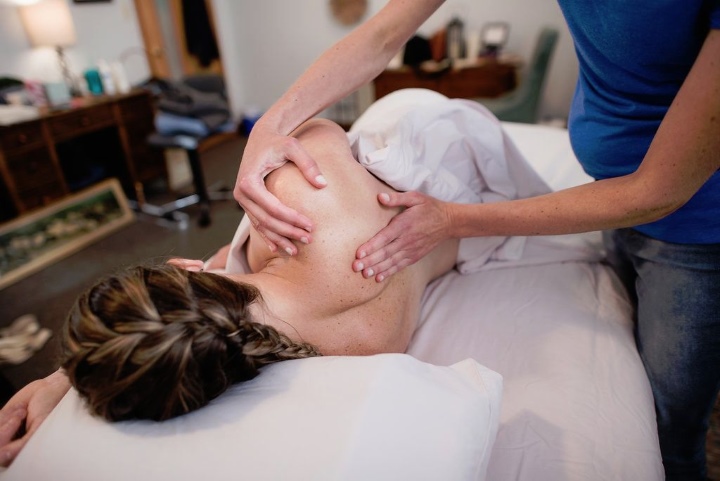Welcoming a new life into the world is a joyous and life-changing experience for any woman. However, the toll it takes on the body during and after pregnancy is undeniable. As a new mother, it’s essential to prioritise self-care and allow yourself time to recover. Postpartum massage, specifically designed to address the needs of new mothers, can be a powerful aid in this process.
In This Article:
- What is Postpartum Massage?
- When Can You Get a Postpartum Massage After Delivery?
- Benefits of Massage After Delivery
- The Best Positions for a Post-Pregnancy Massage
- Postpartum Massage Techniques
- When Should You Avoid Postnatal Massage?
- Precautions for Postnatal Massage If You Had a C-Section
- Which Oil Is The Best For Postpartum Massage?
What is Postpartum Massage?
Postpartum massage is a specialised form of massage therapy tailored to the needs of women who have recently given birth. It focuses on addressing the physical and emotional changes that occur during and after pregnancy. The massage techniques specifically aim to aid in the body’s recovery from childbirth, alleviate muscle tension, and foster relaxation.
When Can You Get a Postpartum Massage After Delivery?
In the immediate postpartum period, it’s crucial to allow your body to rest and recover. Most healthcare providers recommend waiting at least six weeks after delivery before scheduling a postpartum massage. This waiting period allows time for the body to heal and for any postpartum complications to be addressed.
Benefits of Massage After Delivery
Pain Relief:
Postpartum massage can help alleviate the muscle aches and joint pains. The gentle kneading and stretching of the muscles can provide much-needed relief from the physical strain of labour and delivery.
Hormonal Regulation:
Pregnancy and childbirth cause significant fluctuations in hormonal levels. Postpartum massage can aid in hormone regulation, promoting overall emotional well-being and stability during a time of transition.
Stress Reduction:
Caring for a newborn can be overwhelming, and many new mothers experience heightened stress levels. Postpartum massage provides a calming and nurturing environment, allowing mothers to relax, destress, and recharge.
Improved Sleep Quality:
New mothers often struggle to get adequate sleep due to the demands of caring for a newborn. Regular postpartum massage has been shown to improve sleep quality, helping new moms get the rest they need to recover and thrive.
The Best Positions for a Post-Pregnancy Massage
Side-Lying Position:
This is one of the most comfortable positions for postpartum massage, for those who may still be experiencing discomfort when lying on their stomach or back.
Semi-Reclined Position:
Sitting in a semi-reclined position with support behind your back can also be a great way to receive a post-pregnancy massage. This position is ideal for targeting tension in the neck, shoulders, and arms while allowing you to remain comfortable and relaxed.
Modified Child’s Pose:
If you feel comfortable lying on your stomach, the modified child’s pose can be a wonderful position for a postpartum massage. With the help of pillows for support, you can lean forward on a massage table, allowing your therapist to work on your back and shoulders.
Postpartum Massage Techniques
Swedish Massage:
This gentle full-body massage is perfect for easing muscle tension, improving circulation, and promoting relaxation. Your massage therapist will use long, gliding strokes and kneading techniques to soothe sore muscles and release any built-up tension.
Lymphatic Massage:
Post-pregnancy swelling, especially in the feet and legs, is a common concern for many new moms. Lymphatic massage techniques can help reduce swelling by stimulating the lymphatic system and promoting fluid drainage.
Abdominal Massage:
After childbirth, the abdominal muscles may feel sore and tender. A gentle abdominal massage can help alleviate discomfort, improve muscle tone, and promote postpartum healing.
When Should You Avoid Postnatal Massage?
Postnatal massages are generally safe and beneficial for most women after childbirth. However, if you have had a C-section, it’s important to wait until your incision has sufficiently healed before receiving a massage. Typically, it’s recommended to wait at least 6 weeks after a C-section before engaging in any form of massage therapy. This waiting period allows the body to heal and reduces the risk of complications or discomfort during the massage.
Precautions for Postnatal Massage If You Had a C-Section
Once you have received the green light from your healthcare provider to proceed with postnatal massage after a C-section, there are additional precautions to keep in mind to ensure a safe and comfortable experience:
Gentle Techniques:
When receiving a postnatal massage after a C-section, it’s important to communicate with your massage therapist about your recent childbirth experience. They should use gentle and cautious techniques, avoiding direct pressure on the C-section incision site.
Supportive Positioning:
Opt for a massage therapist who has experience in postnatal care and understands the specific positioning and support needed for women who have undergone a C-section. Proper positioning can help alleviate any strain on the incision area.
Healing Benefits:
A postnatal massage tailored for women who have had a C-section can focus on promoting healing, reducing scar tissue formation, and addressing any lingering discomfort in the lower back, hips, and pelvic region.
Which Oil Is The Best For Postpartum Massage?
When it comes to selecting the ideal oil for postpartum massage, it’s crucial to choose one that is safe, nourishing, and has therapeutic benefits. Here are some top picks for postpartum massage oils:
Coconut Oil
Known for its moisturising and nourishing properties, coconut oil is a popular choice for postpartum massage. It is gentle on the skin and can help alleviate any dryness or irritation.
Sweet Almond Oil
With its lightweight and non-greasy texture, sweet almond oil is an excellent option for postpartum massage. It is easily absorbed by the skin, providing hydration without clogging pores.
Jojoba Oil
Jojoba oil closely resembles the natural oils produced by the skin, making it a fantastic choice for postpartum massage. It is non-comedogenic, and has anti-inflammatory properties, which can be soothing for the skin.
Olive Oil
Olive oil is rich in antioxidants and vitamins, making it nourishing for the skin. It can help with moisturising and promoting skin elasticity, which can be especially beneficial during the postpartum period.
Conclusion
In conclusion, postpartum massage plays a valuable role in supporting the physical and emotional well-being of pregnant women during the postpartum period. Through its ability to alleviate physical discomfort, reduce swelling, and promote relaxation, postpartum massage offers a holistic approach to postpartum recovery. As with any postpartum practice, it’s important for pregnant women to approach postpartum massage with caution and seek professional guidance to ensure that it is safe and suitable for their individual needs.
Sources:
- https://www.healthline.com/health/postpartum-massage
- https://www.webmd.com/baby/benefits-postpartum-massage













